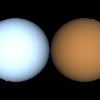specular()#
Sets the specular color of the materials used for shapes drawn to the screen, which sets the color of highlights.
Examples#

def setup():
py5.size(100, 100, py5.P3D)
py5.background(0)
py5.no_stroke()
py5.background(0)
py5.fill(0, 51, 102)
py5.light_specular(255, 255, 255)
py5.directional_light(204, 204, 204, 0, 0, -1)
py5.translate(20, 50, 0)
py5.specular(255, 255, 255)
py5.sphere(30)
py5.translate(60, 0, 0)
py5.specular(204, 102, 0)
py5.sphere(30)
Description#
Sets the specular color of the materials used for shapes drawn to the screen, which sets the color of highlights. Specular refers to light which bounces off a surface in a preferred direction (rather than bouncing in all directions like a diffuse light). Use in combination with emissive(), ambient(), and shininess() to set the material properties of shapes.
This method has additional color functionality that is not reflected in the method’s signatures. For example, you can pass the name of a color (e.g. “green”, “mediumpurple”, etc). Look at the online “All About Colors” Python Ecosystem Integration tutorial for more information.
Underlying Processing method: specular
Signatures#
specular(
gray: float, # value between black and white, by default 0 to 255
/,
) -> None
specular(
rgb: int, # color to set
/,
) -> None
specular(
v1: float, # red or hue value (depending on current color mode)
v2: float, # green or saturation value (depending on current color mode)
v3: float, # blue or brightness value (depending on current color mode)
/,
) -> None
Updated on December 25, 2023 16:36:33pm UTC
